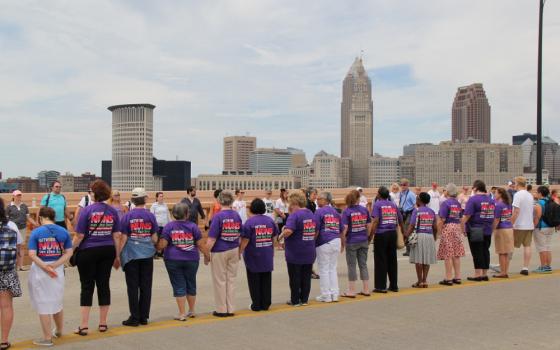Check your social media feed or turn on the news these days and you will see and hear much to make you anxious, worried, sad, pessimistic or fearful. Whether it is the actions of a disturbed person armed with lethal weapons in a crowded place or someone who should know better using his outsized media presence to spread a message of fear, hate and isolationism, the end result is enough to tempt the best of us to hide under the covers.
No matter how hard it is to take in, I believe we need to keep our eyes, ears and hearts open. It is not enough to simply ignore words, actions or realities that we find reprehensible or frightening. We need to infuse hope into a climate of worry, anxiety and fear, starting in our own hearts and homes.
Today is the Feast of St. Martha. Martha was a woman who, as Jesus tells us, was "anxious and worried about many things" (Luke 10:41). There is an aura of reality that comes with Martha as depicted in the Gospels. She was not afraid to look at the world around her and tell Jesus exactly what she thought. When I imagine her running out to tell Jesus that her brother Lazarus had died, I can't help but see the tears running down her cheeks and hear the way her throat must have caught when she said to him, "If you had been here, my brother would not have died" (John 11: 21). I wonder if her hands weren't even on her hips as she uttered this half plea, half accusation to her friend Jesus in her grief.
Martha was indeed real, living in a world where some things just needed to get done, even if her sister Mary was too busy to help. She also lived in a world where the people she loved were suffering. I suspect there may have been times when she too wanted to hide under the covers.
Martha certainly had her own doubts about what was possible in such a world. When Jesus asked her to roll away the stone from her brother's tomb, she warned him that the smell would be overpowering given that her brother had been dead for four days.
Yet Martha — worried, anxious and doubting as any real woman would be in the face of such stark realities — also listened to the hope and promise of Jesus. She made a home for hope in her heart. She helped to roll away the stone, and her brother Lazarus came out, ready to be unbound and free. We have a lot to learn from Martha, who in the end engaged in hopeful action in the midst of her own anxiety, worry and grief.
Hope sometimes gets a bad rap as being ephemeral Pollyanna nonsense. Indeed, hope by itself does not fill empty stomachs or stem the tide of senseless violence all around us. Nor is hope likely to change a serious medical diagnosis or bring our own loved ones back from the dead. Hope may not even, in the end, result in sensible public policy or in an election geared toward the common good.
What making a home for hope does do, however, is shift how we see the suffering around us. It brings new possibilities to light and orients our response toward a future. Hope keeps us from hiding under the covers and eggs us on to action.
We need the nudge of hope.
This became crystal clear to me last week when I was passing out lemonade at the Republican National Convention, asking folks what gives them hope for our nation. This pointed question surprised people. Here they were all riled up and ready to talk about everything that is wrong with the country, the other party, a political candidate, the economy, our social fabric, you name it — but when asked about hope, they had to stop and take another look at that same reality with different eyes.
Hope, Gustavo Gutiérez writes, is capable "of breaking out and remaining creative and alive even in the midst of difficult situations." There is an active dimension to hope. We cannot hide under the covers, nor can we wait for someone else to wave a magic wand to heal the divided places in our communities.
In the midst of fear, division, suffering and struggle, hope needs a home so that it can take root. We owe it to ourselves to make a home for hope. Only then will we be able to help roll away the stone.
[Susan Rose Francois is a member of the Congregation Leadership Team for the Sisters of St. Joseph of Peace. She was a Bernardin scholar at Catholic Theological Union and has ministered as a justice educator and advocate. Read more of her work on her blog, At the Corner of Susan and St. Joseph.]
Related, by Sr. Laura Hammel, Sisters of St. Clare, a Poor Clare community in Saginaw, Michigan - The lesson from Jesus' meeting with Martha and Mary


